Mango, commonly known as Mangifera indica, is a species of flowering plant in the Anacardiaceae family. Mango is generally called the ‘King of Fruits’ and is a summertime staple in households worldwide. Mango trees grow in almost any soil, be it sandy, loam or clay, but they need good depth and drainage. When your Mango tree is young, it will need regular watering depending on its growth and climate.
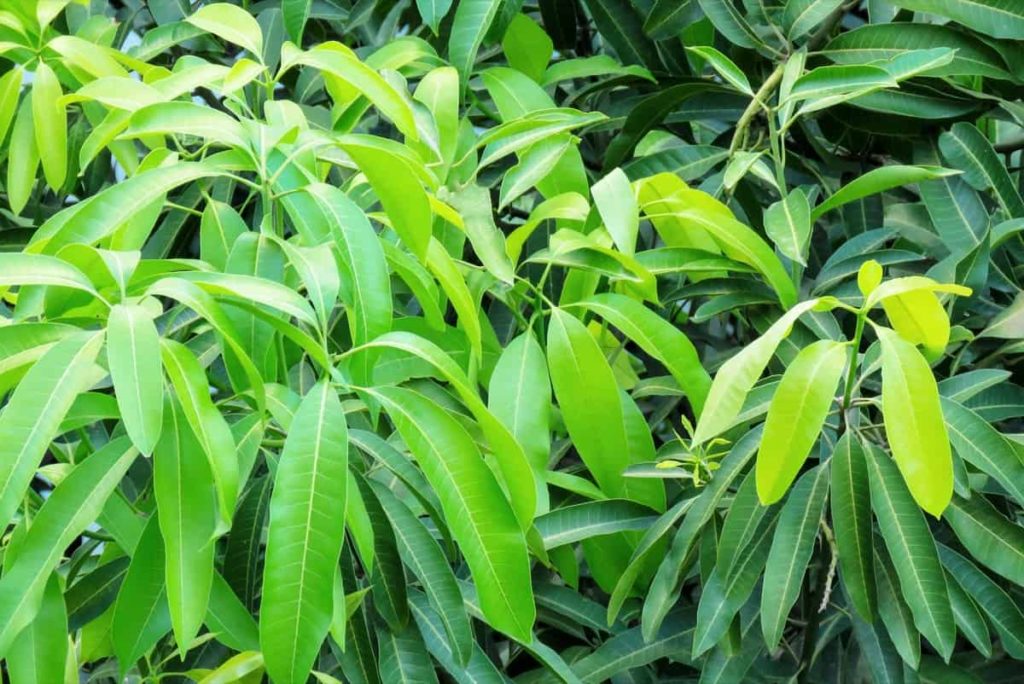
A guide to understanding Mango tree propagation
What is Mango grafting?
Grafting is a rapid vegetative propagation technique that grows plants to resemble the intended parent tree. Propagation is raising new plants from various sources: seeds, cuttings, bulbs, and other plant parts. Grafted Mango trees take less time to flower and bear fruit. With all grafting, observe the following points:
- Maintain good hygiene
- Use healthy, strong rootstock
- Use healthy graft or bud wood with active buds
- Keep unused bud wood in plastic and store it in the refrigerator or freezer
- Use fresh bud wood if possible
- Always cover the fresh graft with a plastic bag to create a warm, humid environment
- If grafting in full sunlight, cover the plastic bag with a brown paper bag to prevent overheating
- Do not overwater after transplanting
- Keep the grafting knife clean and sharp, and only make single cuts when grafting
- Always match the cambium layers on one side during the tying process – don’t worry if the two sides don’t match
- Use young grafting wood if possible
How do you propagate Mangoes?
Trees planted from seeds have deep roots, thus increasing anchorage and nutrient seeking. Several methods of plant breeding have been tried with varying degrees of success. Propagation from seed, though easy and cheap, cannot retain the characters of the parent tree as most commercial varieties are cross-pollinated and mono-embryonic. Plants also take longer to bear fruit. However, plants must be grown to be used as rootstock. The most suitable height for grafting is about 20-30 cm above ground level.
At this point, the rootstock should be straight, at least pencil-thick, and have green bark. Avoid the area if the bark is old, brown, or corky. Keep the leaves on the stock below the transplant point. Many graft types can be used on Mangoes, but the two most common are the whip and the cleft or wedge graft. The whip graft is widely used by nursery operators and other highly experienced operators, while most other grafters use the wedge graft. Both grafts are fairly easy to perform.
In case you missed it: A Step-By-Step Guide to High Density Fruit Farming: For Guava, Banana, Mango, Pineapple, Lemon, Papaya, Litchi, and Apple
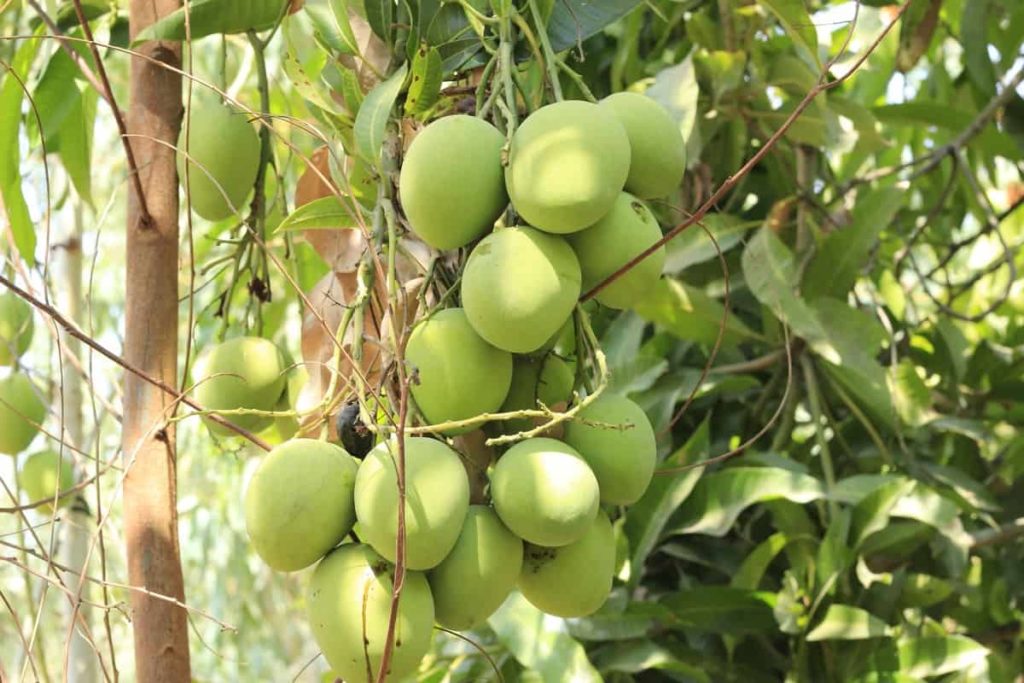
After a little experience and following some basic steps, you will achieve a high percentage of successful ‘takes”. Veneer grafting propagation holds promise for large-scale commercial propagation. The method is simple and can be adopted successfully. Rootstocks specified for inarching are also suitable for this method. For this grafting operation, a 30-40 mm long cut is made downwards and inwards at the height of about 20 cm in the smooth part of the stock. At the base of the cut, a small cut is made to cut first to remove the wood and bark.
A scion stick is given a long diagonal cut on one side and a small short cut on the other to match the stock cuts. The scion is inserted into the stock, so the cambium layers are on the long side. The graft union is then tied with a polyethylene bandage recommended for inarching. After greening for more than 10 days, rootstock should be pruned in stages. Scion wood used for veneer grafting requires a proper preparation. At least one week before transplanting, the desired shoots should be dropped so that the dormant buds in the axil of leaves become swollen.
What is the best propagation method for Mango?
- Grafting is the most common and commercially used, although seed, cuttings, and budding are also important methods of Mango propagation.
- There are three grafting methods: softwood, splice (wipe), and side grafting.
Which Mango grows fastest?
Glenn Mango is a fast-growing, semi-dwarf tropical tree that produces delicious Mangoes without taking up much space.
Does the Mango tree need a lot of water?
- Mango trees do not need daily water. Mangoes need 1 inch (2.5 cm) of water per week. For Mango trees under 2 years old, provide 1 inch of water spread over 2-3 weekly watering sessions.
- For mature Mango trees (over 2 years old), provide 1 inch of water in a once-weekly watering session. When watering Mangoes, it is important to soak the taproot thoroughly and allow the soil to dry out.
- Depending on the climatic conditions and the size of the tree, it may require different amounts of water. The key is ensuring the root zone is soaked without waterlogging the soil. It will ensure maximum growth. Water with a soaker hose or water so that the water soaks into the soil. You want to soak the Mango root in the soil without overwatering it. If water begins to pool on the soil surface, stop watering.
- Use a soaker hose or a large bucket of water to soak the roots of your tree. If used, you run the soaker hose on a low setting. Take frequent breaks during watering to make sure the soil is draining well. If water starts to pool, stop watering immediately. Make sure your tree is planted in a location with ample access to direct sunlight to help eliminate excess moisture. Sunlight helps to evaporate excess water and excess dry moisture quickly.
Why is your Mango tree not growing?
If you are having trouble growing your Mango tree, there could be several reasons it is not growing healthily. Sunlight is an important factor for successful Mango tree growth. Always check or calculate how much sun your Mango tree is getting from your house’s solar number. Some houses have lower solar numbers, which means your sun doesn’t get as much sun as some houses or the sun is farther from the direction of sunrise and sunset.
In case you missed it: Mango Farming in Mexico: How to Start, Planting to Harvesting, and Production Guide
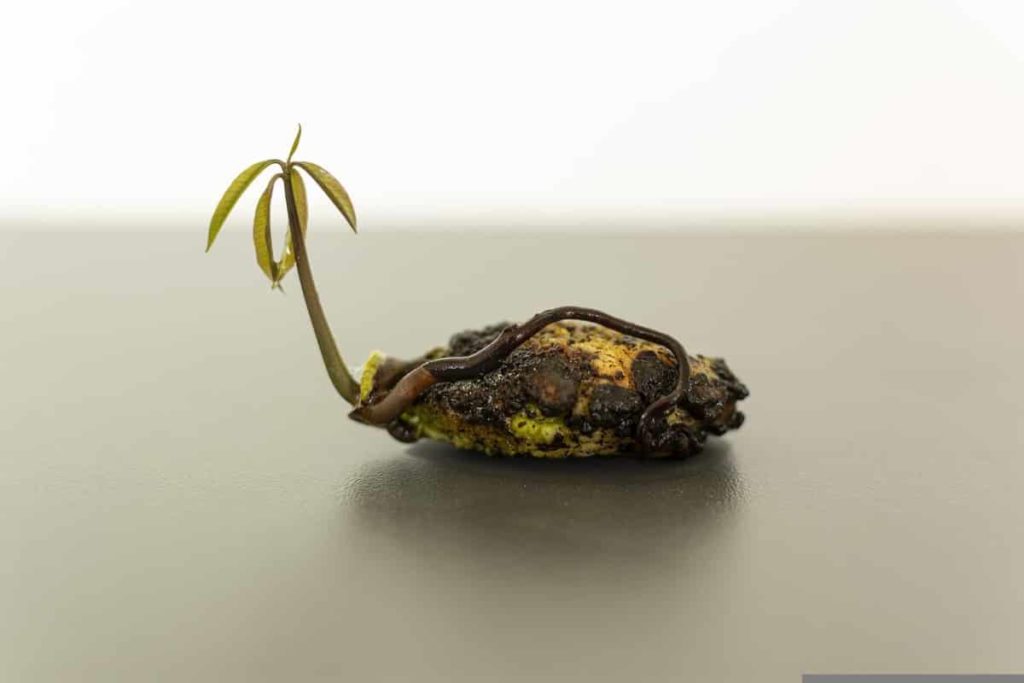
If your roots are cluttered below the soil surface, your Mango tree may have trouble growing due to how the roots grow. You may want to do this if you need to prune them because they are growing in the wrong direction. Nutrients the roots and the whole plant are getting for its growth are very important for producing Mangoes. Make sure your plants are getting the right amount and type of nutrients.
There are many resources out there that supply the nutrients a Mango tree needs. Seed quality can also indicate why your tree is not growing or producing fruit. There may be other reasons, such as weather, cloudiness, insects, and the fertilizer you are using. Make sure you take care of these concerns to ensure that you will harvest high-quality Mangoes. If the Mango tree is not growing, there may be a nutritional problem. Young trees should be fertilized once a month during their first year.
This application can be reduced to 3 to 4 times yearly for more mature trees. A Mango tree surrounded by a beautiful green lawn makes for a beautiful picture. However, this is not good for the tree as the proximity to a manicured lawn can result in too much fertilizer or water. And over-fertilizing and over-watering a Mango tree can prevent the tree from bearing fruit. For optimum health and fruit production, a mature Mango tree should not receive much water except for occasional deep watering during extremely dry periods.
If you use lawn sprinklers that collect water near the Mango roots, the tree may suffer from overwatering, limiting fruit production or quality. If your Mango is not bearing fruit, check its location and exposure. It may be that when you planted the Mango tree, the area received all-day sun, but as time goes by, the surrounding trees have filled in and are now shading it. In this case, you may want to prune neighboring trees to flood your Mango with light.
Can a Mango tree be propagated from stem cuttings?
Yes, but Mango cuttings are difficult to root and are not the best way to grow a Mango tree. The Mango tree can be propagated from cuttings under strictly controlled environmental conditions. Factors affecting the rooting of Mango cuttings are:
- Age of the tree from which the cutting is taken: Mango cuttings can be taken from both young and mature trees, but success rates vary. In some situations, cuttings from mature trees work better than cuttings from young trees. Propagate a polyembryonic Mango tree from a young tree.
- Position of cuttings on the tree: Rooting of Mango cuttings depends on the tree’s position from which the cuttings are taken. Cuttings taken from the base of Mango plants are better than cuttings collected from other places.
- Type of cutting: Semi-hardwood and young seedling cuttings are propagated. Short cuttings root more satisfactorily than long cuttings.
- Rooting media: Rooting media should be free draining. You can mix equal amounts of peat moss or sphagnum moss and sand.
- Timing of cutting: The propagation rate is higher in summer; however, it can be done under controlled conditions in winter.
What kind of soil do Mango trees need?
Mangoes need excellent drainage, so put a layer of broken pots in the bottom of the pot and then a layer of crushed gravel. For a container-grown Mango tree, you will need light but very nutritious soil. Mango can be grown on various soil types, from light sandy loam to red clay soil. A soil pH around of 5.5 to 7.5 is preferred. Deep rich soil gives the best yield and fruit quality. Well-drained soil is recommended. Moderately sloping sites are also recommended to avoid waterlogging.
Deep soil without impervious layers allows for deep root development, which aids in drought tolerance and wind resistance. Mangoes will grow from sea level to about 1,500 feet in Hawaii, but Mangoes are most productive below 1,200 feet. Mangoes are best adapted to hot, dry leeward areas with less than 60 inches of annual rainfall, but supplemental irrigation is necessary for maximum production in these areas.
Anthracnose disease destroys both flowers and developing fruit in humid and high-rainfall areas. Dry weather conditions during the flowering period are best for Mango fruit production. Wind can damage flowers and reduce fruit yields. Mango trees should be protected from strong winds, but avoid winds that shade or oppose them.
When should Mango trees be pruned?
You want to avoid pruning when the foliage shows in late May and around the tree’s flowering time in June. The best time for Mango tree pruning is after harvest and should be done immediately, at least by the end of December. About 25-30% of the midrib is pruned on commercially grown Mangoes to reduce the canopy height and width of large Mango trees. Ideally, the tree will have no more than three to four main trunks, plenty of interior canopy space, and be 12-15 feet tall. All of this is true for the home gardener as well.
Moderate and even severe pruning will not harm the tree, but it will reduce production for one to several seasons, although it is worth it in the long run. Mango trees do not need to be pruned every year. Mango trees are terminal bearers; they flower from the ends of branches and only flower on mature wood about 6 weeks or older.
In case you missed it: Top 14 Steps to Boost Mango Fruit Yield: Methods, Yield Improving Tips, Fertilizer to Increase Fruit Size
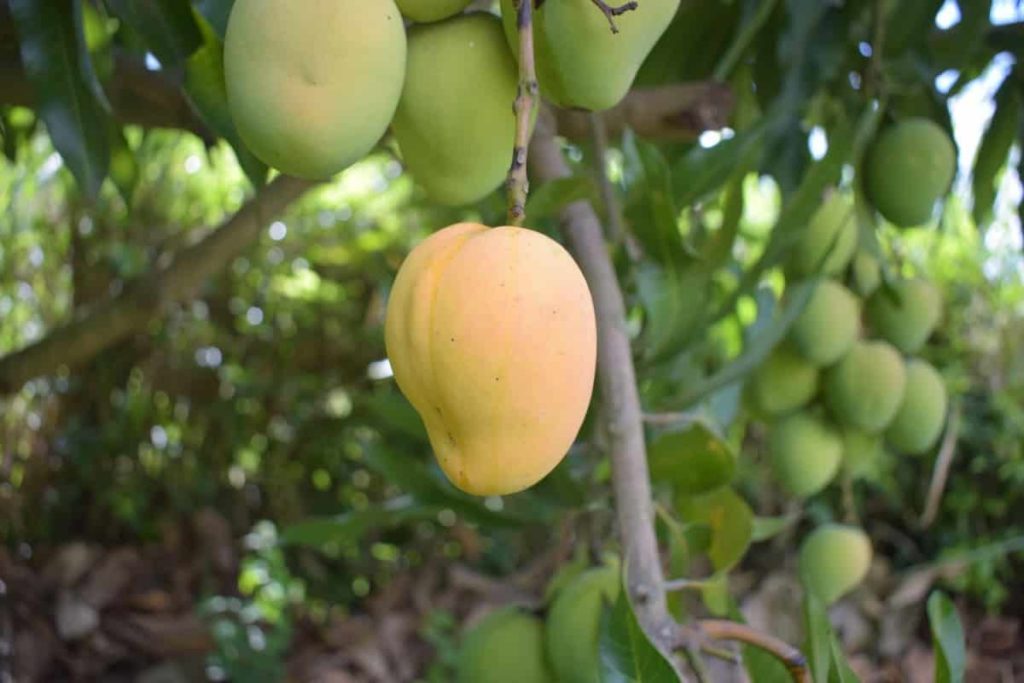
Mangoes begin to bear fruit in the second or third year after planting. Once a tree is fertile, it uses less energy to grow and more to flower and fruit, effectively reducing its vertical and horizontal growth. It will reduce the amount of pruning you need to focus on. Only maintenance pruning or pinching should keep the tree in good condition.
How and when to pick my Mangoes?
- To harvest your Mango, tug at the fruit. If the stem breaks easily, it is ripe. Mangoes are harvested by hand, simply by snapping the fruit from the peduncles in less developed plants or cutting the peduncles 4 inches above the fruit when intended for export. It allows the milky, toxic latex to drain from the stem without touching the surface of the fruit.
- Mangoes are hand-picked four times during the harvesting season. The Mango fruit is harvested at the so-called mature green stage and should not be confused with ripening. Ripe Mango fruits ripen after picking and take ‘buying time’ to handle and distribute the fruit.
How often do you fertilize a Mango tree?
- Fertilize mature Mango trees 2-4 times per calendar year.
- Young Mango trees require monthly fertilization during their first year.
- Increase the amount of fertilizer used each year as your Mango tree grows in size.
Do Mango trees need a lot of suns?
- Mango trees need plenty of sunlight to thrive. Even if you put it in a pot near a window in a room with lots of light, it won’t grow.
- It would help if you had direct sunlight to grow Mangoes.
Can a Mango tree be grown from cuttings?
- The best time to do this is in summer.
- Cut a 6- to 8-inch section of a young, thin branch from a healthy Mango tree, and remove the leaves from the lower half. Also, remove any flowers or fruit.
- After that, dip the cut end in the rooting hormone and plant the cutting in a small container with moist soilless potting mix.
- The container should have drainage holes. Keep the container in a warm and humid place with bright, indirect light. And keep the growing medium moist but not wet. It may take several weeks for sufficient root growth.
How much time does it take for a Mango tree to grow from grafting?
Grafted Mango trees bear fruit about three to five years after planting, earlier than trees started from seed.
How much time does it take to grow a Mango tree from seed?
- The Mango tree takes about five to eight years to bear fruit from seed. A nursery plant bears fruit in about four years.
- After the tree flowers, it takes three to five months for the Mango fruit to ripen.
How do you propagate a Mango tree from seed?
- Mango trees grow easily from seed. Get a fresh Mango pit and cut off the tough skin. Remove the seed inside and plant it in a large pot of seed starter mix. Spreading the seed ¼-inch above the soil surface works best for growing Mango trees. Keep the soil evenly moist, then place the pot where the temperature stays at least 21°C.
- Germination can occur as early as eight to 14 days but may take up to three weeks. Remember that your new Mango tree will not bear fruit for at least six years.
- Mango seeds are planted in summer, as there are many hours of sunlight, which helps the tree to grow.
In case you missed it: Best Fertilizer for Mango Tree: When to Apply and How To Apply
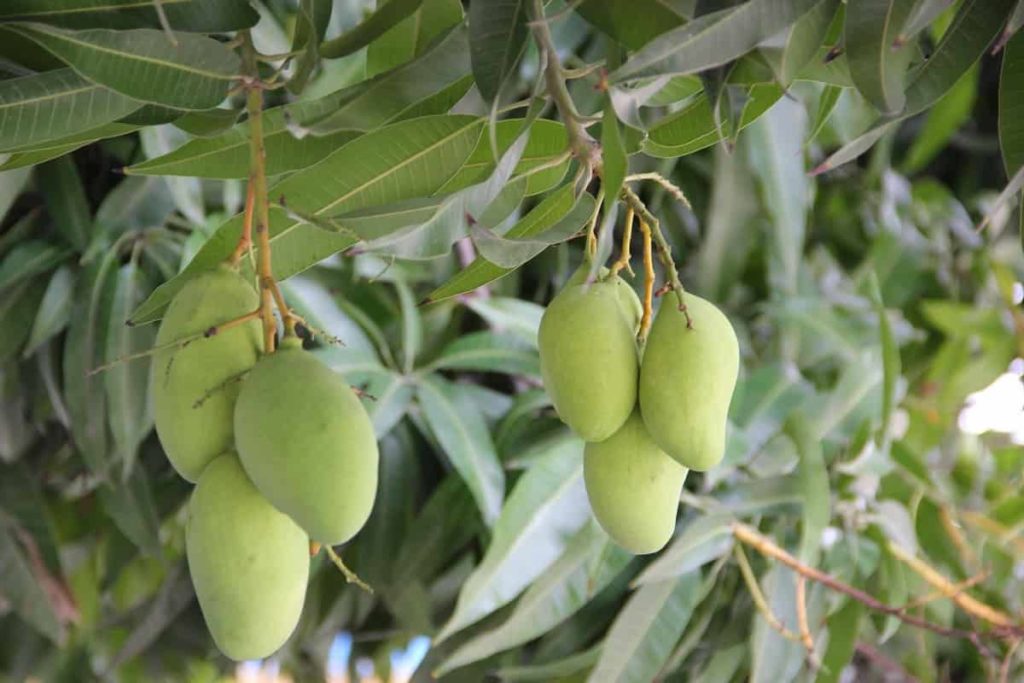
Is Mango propagated by budding?
- Bud grafting of a Mango tree combines two trees to form one more favorable tree. The wood, or scion, from the desired tree, is inserted into the base, or rootstock, of the existing tree. Scion produces stems, branches, and fruit on the grafted tree.
- Cut a 6-inch bud just below the apical, or top bud, with a sharp knife. Remove all leaves from the branch. Cut the bottom of the scion with a bevel cut about 1-1/4 inches long on each side of the terminal, or bottom, to make a sharp point.
- Saw or cut off the top of the rootstock, 1 foot above the soil line. Remove the remaining buds. Make a 1-inch deep cut, or slit, at the top of the stem of the rootstock.
- Insert the sapling into the crack so that the inner wood of the scion is flat against the inner wood of the rootstock, leaving 1/3 inch of the rootstock exposed. Wrap the graft tightly with grafting tape.
How to grow a Mango from seed in a paper towel?
- One of the most popular methods is growing Mangoes from paper towel seeds. Fairly straightforward, with a success rate, it’s also an ideal method if you’re not patient and wants to watch your seed progress – though try to resist opening it too often.
- It’s also the least expensive way to start because it only requires two paper towels, a Ziploc bag, and Mango seeds.
- After separating the Mango flesh from the seed – just like when you prepare a Mango to eat – rub the seed husk to remove the flesh. Do this with a standard kitchen knife. Once you peel off the husk, it will be white and slightly sweet. Then cut a small nick in the top (thin end) of the husk and submerge it completely in a glass of water for 24 hours.
- After 24 hours, remove the husk from the water. You can remove the seed from the husk (you can value it by cutting the edge of the husk and then opening it with a knife), or you can put the seed in the husk. Wrap your Mango seed in a damp paper towel.
- Place the wrapped Mango seeds in a plastic bag with small air holes. Keep the seed warm and moist to help it germinate quickly. You will start to see signs of improvement within a few days. Once the seed germinates and produces roots and shoots, plant in compost and water well.
How do mango trees grow in pots?
Most dwarf Mango trees are typically 4 to 8 feet tall, making them ideal for growing in pots. With container growing, you can place your tree in an easily accessible location for harvesting, and you don’t need to dedicate a lot of garden space to it. Spring is the best time to plant Mango trees in containers.
Choose a container at least 20 inches tall and wide with plenty of drainage holes. An unglazed clay container is best because it will allow more of the clay’s moisture to escape through its walls. Place it on a plant caddy with rolling casters for easy movement.
Which month is best for Mango grafting?
- Only attempt grafting when the rootstock is strong, and buds have swelled on the suture wood.
- Best results are achieved during hot, humid weather – usually from January to April.
- You may be successful at other times of the year by artificially raising the temperature and humidity.
How to grow a Mango tree faster?
- Mango trees require a lot of nutrients. Apply a high-nitrogen fertilizer twice a year when the tree is young to encourage strong, leafy growth.
- Once the Mango tree begins to flower and bear fruit, usually two to four years after planting the transplanted tree, switch to a fertilizer mix high in phosphorus and potassium. The mixture should be applied two to four times.
- Mango trees can grow slowly due to cold weather, poor soil, or lack of water. Prepare the soil with manure, old cow dung, and chicken manure to make the Mango tree grow faster. Mulch with 2 to 3 inches of straw or sugar cane mulch gives it a super boost shot of fish emulsion.
- Mulch is one of the most important ways to help your Mango tree grow faster. Straw or sugarcane mulch make excellent mulches for young trees because they break down quickly to improve the soil. Light mulches will feed insects, suppress weeds, and hold water in the soil.
- A Mango tree will grow faster if it is well fed with organic fertilizers during the hot growing season. A top dressing of liquid nitrogen feed, pelleted chicken manure, and aged cow manure will supercharge the soil ready for the rapid growth of the Mango tree.
In case you missed it: High Density Mango and Ultra High Density Plantation Per Acre, Yield In India
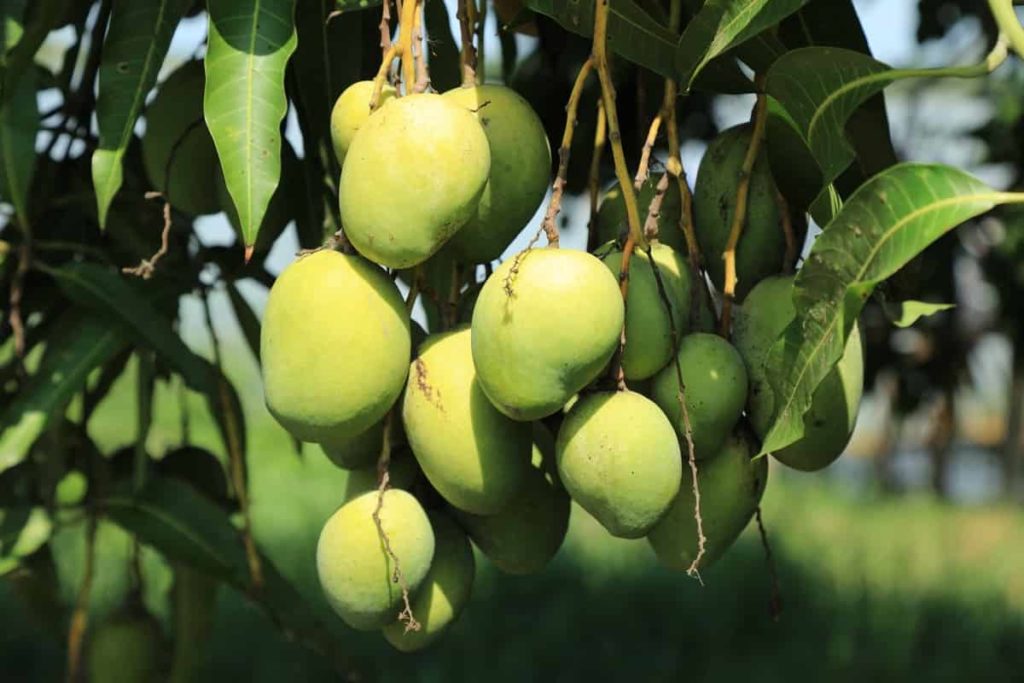
Conclusion
Mango’s economic and nutritional value, fruit beauty, and flavor appeal make it one of the most cultivated tropical fruits in the world. Establishing a healthy, productive Mango tree requires planning and preparation. Once you have determined that the climate and soil are suitable and selected species, you must also determine how to propagate the planting material.
A Mango tree can be grown from cuttings taken from a healthy Mango tree. However, the success rate of growing Mango trees from stem cuttings is low. A Mango tree can be easily propagated from seed and cuttings with a very high success rate.
- Types of Pesticides Used in Agriculture: A Beginner’s Guide
- Economical Aquaculture: A Guide to Low-Budget Fish Farming
- 15 Common Planting Errors That Can Doom Your Fruit Trees
- How to Make Houseplants Bushy: Effective Tips and Ideas
- Innovative Strategies for Boosting Coconut Pollination and Yield
- Pollination Strategies for Maximum Pumpkin Yield
- The Complete Guide to Chicken Fattening: Strategies for Maximum Growth
- Natural Solutions for Tulip Problems: 100% Effective Remedies for Leaf and Bulb-Related Issues
- Revolutionizing Citrus Preservation: Towards a Healthier, Greener Future
- Natural Solutions for Peony Leaf and Flower Problems: 100% Effective Remedies
- Maximizing Profits with Avocado Contract Farming in India: A Comprehensive Guide
- Natural Solutions for Hydrangea Problems: 100% Effective Remedies for Leaf and Flowers
- The Ultimate Guide to Choosing the Perfect Foliage Friend: Bringing Life Indoors
- From Sunlight to Sustainability: 15 Ways to Use Solar Technology in Agriculture
- The Ultimate Guide to Dong Tao Chicken: Exploring from History to Raising
- The Eco-Friendly Makeover: How to Convert Your Unused Swimming Pool into a Fish Pond
- Mastering the Art of Delaware Chicken Farming: Essentials for Healthy Backyard Flocks
- 20 Best Homemade Fertilizers for Money Plant: DIY Recipes and Application Methods
- How to Craft a Comprehensive Free-Range Chicken Farming Business Plan
- Brighten Your Flock: Raising Easter Egger Chickens for Beauty and Bounty
- How to Optimize Your Poultry Egg Farm Business Plan with These Strategies
- Subsidy for Spirulina Cultivation: How Indian Government Schemes Encouraging Spirulina Farmers
- Ultimate Guide to Raising Dominique Chickens: Breeding, Feeding, Egg-Production, and Care
- Mastering the Art of Raising Jersey Giant Chickens: Care, Feeding, and More
- Ultimate Guide to Raising Legbar Chickens: Breeding, Farming Practices, Diet, Egg-Production
- How to Raise Welsummer Chickens: A Comprehensive Guide for Beginners
- How to Protect Indoor Plants in Winter: A Comprehensive Guide
- Ultimate Guide to Grow Bag Gardening: Tips, Tricks, and Planting Ideas for Urban Gardeners
- Guide to Lotus Cultivation: How to Propagate, Plant, Grow, Care, Cost, and Profit
- Agriculture Drone Subsidy Scheme: Government Kisan Subsidy, License, and How to Apply Online
- Ultimate Guide to Raising Araucana Chickens: Breed Profile, Farming Economics, Diet, and Care
- Bringing Hydroponics to Classroom: Importance, Benefits of Learning for School Students
- Ultimate Guide to Raising Polish Chickens: Breed Profile, Farming Economics, Diet, and Care
- Ultimate Guide to Raising Australorp Chickens: Profile, Farming Economics, Egg Production, Diet, and Care
- Silkie Chicken Farming: Raising Practices, Varieties, Egg Production, Diet, and Care
- Sussex Chicken Farming: Raising Practices, Varieties, Egg Production, Diet and Care